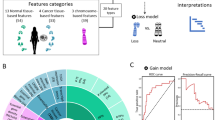Summary
The chromosomes of an established human glioma cell line were studied with G-band technique. The cell line had a hypotriploid mode, S=60−61, and there were 10 different marker types in the stemline karyotypes. The origin of most markers could be traced; C and D chromosomes were found to participate in the formation of at least eight markers. The findings in the present material, combined with the observations in a previously studied glioma cell line, indicated a preferential pattern of variation in chromosome groups C and D.
Zusammenfassung
Die Chromosomen einer humanen Gliomazellkultur wurden mit der G-Bandungstechnik untersucht. Die Kultur hatte eine hypotriploide Stammlinie (S=60−61) mit zehn verschiedenen Marker-Chromosomen im Stammliniekaryotypen. Der Ursprung der Mehrzahl der Marker-Chromosomen konnte festgestellt werden; die Chromosomen der Gruppe C und D hatten bei mindestens acht Markers an deren Bildung teilgenommen. Die vorliegende und eine frühere Untersuchung von Gliomakulturen deuten darauf hin, daß spezielle Chromosomen der Gruppen C und D an der Entwicklung des Stammliniekaryotypen dieser Tumoren beteiligt sind.
Similar content being viewed by others
References
Mark, J.: Chromosomal characteristics of neurogenic tumours in adults. Hereditas (Lund)68, 61–100 (1971)
Mark, J.: Chromosomal characteristics of secondary human brain tumours. Europ. J. Cancer8, 399–407 (1972)
Mark, J.: The fluorescence karyotypes of three human meningiomas with hyperdiploid-hypotriploid stemlines. Acta neuropath. (Berl.)25, 46–53 (1973a)
Mark, J.: Origin of the ring chromosome in a human recurrent meningioma studied with G-band technique. Acta path. microbiol. scand., sect. A,81, 588–590 (1973b)
Mark, J., Pontén, J., Westermark, B.: G-band analyses of an established cell line of a human malignant glioma. Humangenetik22, 323–326 (1974)
Paris Conference (1971): Standardization in human cytogenetics. Birth Defects: Original Article Series, VIII, 7. New York: The National Foundation 1972
Pearson, P.: The use of new staining techniques for human chromosome identification. J. med. Genet.9, 264–275 (1972)
Pontén, J., Macintyre, E. H.: Long term culture of normal and neoplastic human glia. Acta path. microbiol. scand., sect. A,74, 465–486 (1968)
Westermark, B., Pontén, J., Hugosson, R.: Determinants for the establishment of permanent tissue culture lines from human gliomas. Acta path. microbiol. scand., sect. A,81, 791–805 (1973)
Author information
Authors and Affiliations
Rights and permissions
About this article
Cite this article
Mark, J., Pontén, J. & Westermark, B. Origin of the marker chromosomes in an established hypotriploid glioma cell line studied with G-band technique. Acta Neuropathol 29, 223–228 (1974). https://doi.org/10.1007/BF00685257
Received:
Accepted:
Issue Date:
DOI: https://doi.org/10.1007/BF00685257




